Analyzing the Australian Economy's Response to Chinese Economic Shifts
VerifiedAdded on 2022/10/15
|11
|2519
|14
Essay
AI Summary
This essay examines the detrimental impact of the declining Chinese economy on the Australian financial market. It begins by highlighting the dependence of the Australian economy on China, particularly in commodity consumption, and notes the negative effects of GDP and inflation. The essay then ...
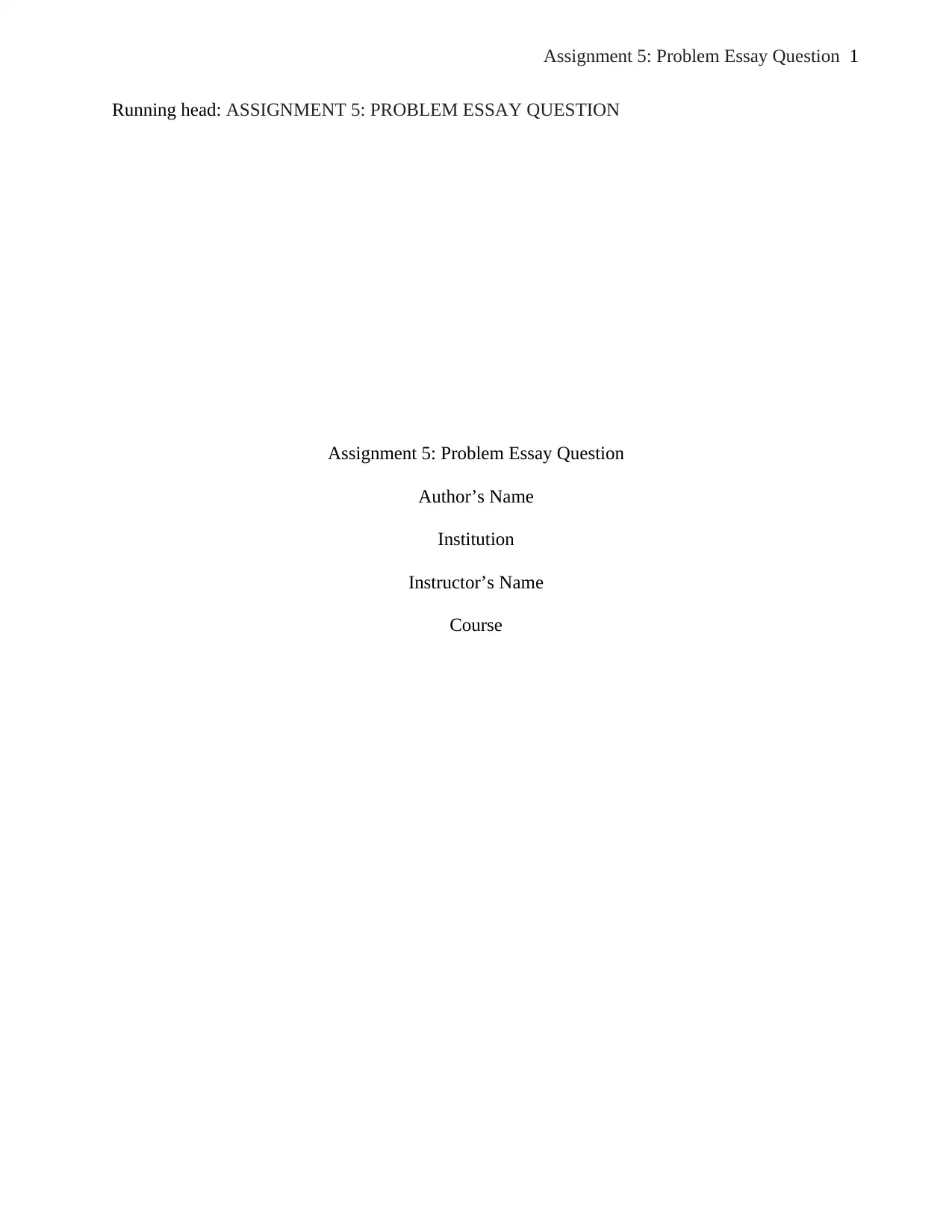
1Assignment 5: Problem Essay Question
Running head: ASSIGNMENT 5: PROBLEM ESSAY QUESTION
Assignment 5: Problem Essay Question
Author’s Name
Institution
Instructor’s Name
Course
Running head: ASSIGNMENT 5: PROBLEM ESSAY QUESTION
Assignment 5: Problem Essay Question
Author’s Name
Institution
Instructor’s Name
Course
Paraphrase This Document
Need a fresh take? Get an instant paraphrase of this document with our AI Paraphraser
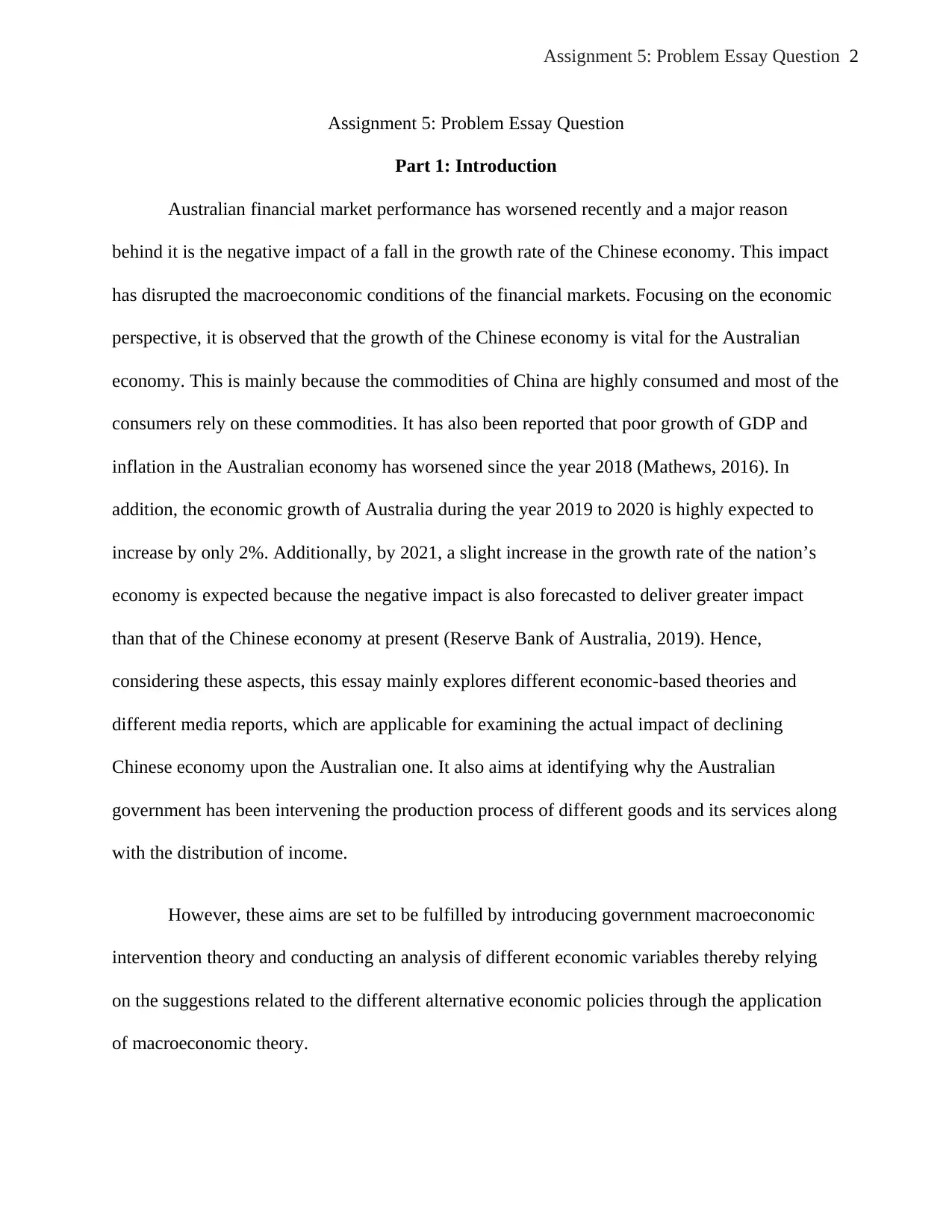
2Assignment 5: Problem Essay Question
Assignment 5: Problem Essay Question
Part 1: Introduction
Australian financial market performance has worsened recently and a major reason
behind it is the negative impact of a fall in the growth rate of the Chinese economy. This impact
has disrupted the macroeconomic conditions of the financial markets. Focusing on the economic
perspective, it is observed that the growth of the Chinese economy is vital for the Australian
economy. This is mainly because the commodities of China are highly consumed and most of the
consumers rely on these commodities. It has also been reported that poor growth of GDP and
inflation in the Australian economy has worsened since the year 2018 (Mathews, 2016). In
addition, the economic growth of Australia during the year 2019 to 2020 is highly expected to
increase by only 2%. Additionally, by 2021, a slight increase in the growth rate of the nation’s
economy is expected because the negative impact is also forecasted to deliver greater impact
than that of the Chinese economy at present (Reserve Bank of Australia, 2019). Hence,
considering these aspects, this essay mainly explores different economic-based theories and
different media reports, which are applicable for examining the actual impact of declining
Chinese economy upon the Australian one. It also aims at identifying why the Australian
government has been intervening the production process of different goods and its services along
with the distribution of income.
However, these aims are set to be fulfilled by introducing government macroeconomic
intervention theory and conducting an analysis of different economic variables thereby relying
on the suggestions related to the different alternative economic policies through the application
of macroeconomic theory.
Assignment 5: Problem Essay Question
Part 1: Introduction
Australian financial market performance has worsened recently and a major reason
behind it is the negative impact of a fall in the growth rate of the Chinese economy. This impact
has disrupted the macroeconomic conditions of the financial markets. Focusing on the economic
perspective, it is observed that the growth of the Chinese economy is vital for the Australian
economy. This is mainly because the commodities of China are highly consumed and most of the
consumers rely on these commodities. It has also been reported that poor growth of GDP and
inflation in the Australian economy has worsened since the year 2018 (Mathews, 2016). In
addition, the economic growth of Australia during the year 2019 to 2020 is highly expected to
increase by only 2%. Additionally, by 2021, a slight increase in the growth rate of the nation’s
economy is expected because the negative impact is also forecasted to deliver greater impact
than that of the Chinese economy at present (Reserve Bank of Australia, 2019). Hence,
considering these aspects, this essay mainly explores different economic-based theories and
different media reports, which are applicable for examining the actual impact of declining
Chinese economy upon the Australian one. It also aims at identifying why the Australian
government has been intervening the production process of different goods and its services along
with the distribution of income.
However, these aims are set to be fulfilled by introducing government macroeconomic
intervention theory and conducting an analysis of different economic variables thereby relying
on the suggestions related to the different alternative economic policies through the application
of macroeconomic theory.
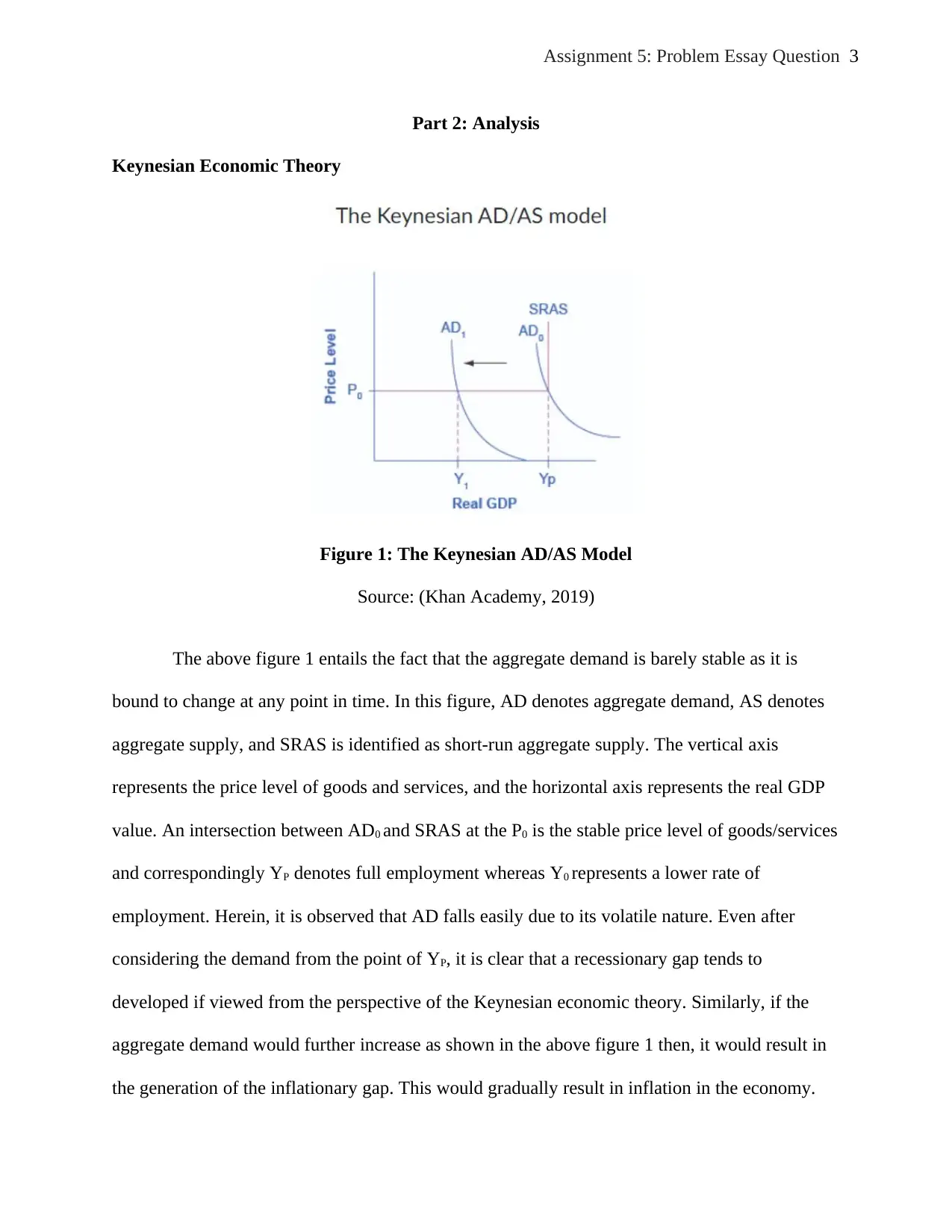
3Assignment 5: Problem Essay Question
Part 2: Analysis
Keynesian Economic Theory
Figure 1: The Keynesian AD/AS Model
Source: (Khan Academy, 2019)
The above figure 1 entails the fact that the aggregate demand is barely stable as it is
bound to change at any point in time. In this figure, AD denotes aggregate demand, AS denotes
aggregate supply, and SRAS is identified as short-run aggregate supply. The vertical axis
represents the price level of goods and services, and the horizontal axis represents the real GDP
value. An intersection between AD0 and SRAS at the P0 is the stable price level of goods/services
and correspondingly YP denotes full employment whereas Y0 represents a lower rate of
employment. Herein, it is observed that AD falls easily due to its volatile nature. Even after
considering the demand from the point of YP, it is clear that a recessionary gap tends to
developed if viewed from the perspective of the Keynesian economic theory. Similarly, if the
aggregate demand would further increase as shown in the above figure 1 then, it would result in
the generation of the inflationary gap. This would gradually result in inflation in the economy.
Part 2: Analysis
Keynesian Economic Theory
Figure 1: The Keynesian AD/AS Model
Source: (Khan Academy, 2019)
The above figure 1 entails the fact that the aggregate demand is barely stable as it is
bound to change at any point in time. In this figure, AD denotes aggregate demand, AS denotes
aggregate supply, and SRAS is identified as short-run aggregate supply. The vertical axis
represents the price level of goods and services, and the horizontal axis represents the real GDP
value. An intersection between AD0 and SRAS at the P0 is the stable price level of goods/services
and correspondingly YP denotes full employment whereas Y0 represents a lower rate of
employment. Herein, it is observed that AD falls easily due to its volatile nature. Even after
considering the demand from the point of YP, it is clear that a recessionary gap tends to
developed if viewed from the perspective of the Keynesian economic theory. Similarly, if the
aggregate demand would further increase as shown in the above figure 1 then, it would result in
the generation of the inflationary gap. This would gradually result in inflation in the economy.
⊘ This is a preview!⊘
Do you want full access?
Subscribe today to unlock all pages.

Trusted by 1+ million students worldwide

4Assignment 5: Problem Essay Question
Theory of Government Macroeconomic Intervention
The Keynesian economic theory basically helps in determining the faults such as lack of
employment and income distribution in an inequitable form. Identifying these areas tend to assist
in driving the growth and development of an economy. Examination in terms of aggregate
demand and supply is also possible through the application of Keynesian economic theory. Since
investment decisions are observed to be crucial for the investors, their future expectations usually
become higher. The idea associated with this theory further portrays that expectations of
economic development and GDP growth are only possible if people from a nation decides to sell
their goods and services to other countries (Khan Academy, 2019). Evidence suggests that the
fall of economic growth of Brazil was due to the global economic crisis, which took place during
the year 2007 to 2008. In addition, the economic recession that occurred in 2009 delivered a
devastating impact on the Brazilian economy. The global economic crisis also involves a decline
in the Chinese economy. Economic growth and development of Brazil declined for the three
consecutive years. Furthermore, economic analysis through the application of Keynesian
economic theory helped in determining crucial needs in order to stabilize the economy. Besides,
five major economic approaches were initiated and the first approach highlighted a major need
for introducing macroeconomic policies by the Brazilian government (Cunha, Ferrari-Filho, &
Prates, 2011).
The Decline in the Brazilian Economy
During the recession in 2009, a need for introducing monetary policy, fiscal policy, and
policy of exchange rate were required to form an economic equilibrium in Brazil. In this
situation, it could be understood that there is an urgent need for a process through which newly
developed policies can be coordinated. However, these tax policies were further referred to as
Theory of Government Macroeconomic Intervention
The Keynesian economic theory basically helps in determining the faults such as lack of
employment and income distribution in an inequitable form. Identifying these areas tend to assist
in driving the growth and development of an economy. Examination in terms of aggregate
demand and supply is also possible through the application of Keynesian economic theory. Since
investment decisions are observed to be crucial for the investors, their future expectations usually
become higher. The idea associated with this theory further portrays that expectations of
economic development and GDP growth are only possible if people from a nation decides to sell
their goods and services to other countries (Khan Academy, 2019). Evidence suggests that the
fall of economic growth of Brazil was due to the global economic crisis, which took place during
the year 2007 to 2008. In addition, the economic recession that occurred in 2009 delivered a
devastating impact on the Brazilian economy. The global economic crisis also involves a decline
in the Chinese economy. Economic growth and development of Brazil declined for the three
consecutive years. Furthermore, economic analysis through the application of Keynesian
economic theory helped in determining crucial needs in order to stabilize the economy. Besides,
five major economic approaches were initiated and the first approach highlighted a major need
for introducing macroeconomic policies by the Brazilian government (Cunha, Ferrari-Filho, &
Prates, 2011).
The Decline in the Brazilian Economy
During the recession in 2009, a need for introducing monetary policy, fiscal policy, and
policy of exchange rate were required to form an economic equilibrium in Brazil. In this
situation, it could be understood that there is an urgent need for a process through which newly
developed policies can be coordinated. However, these tax policies were further referred to as
Paraphrase This Document
Need a fresh take? Get an instant paraphrase of this document with our AI Paraphraser
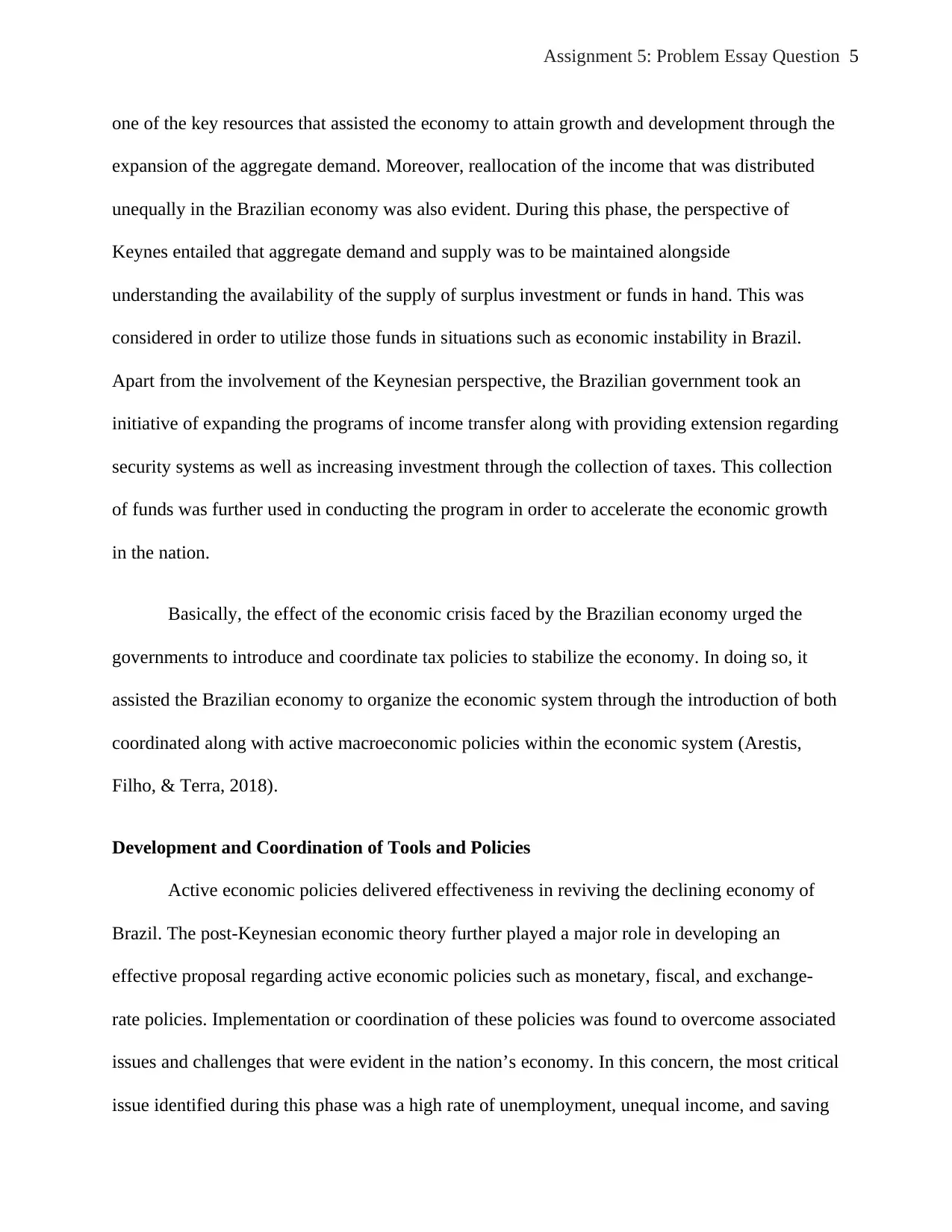
5Assignment 5: Problem Essay Question
one of the key resources that assisted the economy to attain growth and development through the
expansion of the aggregate demand. Moreover, reallocation of the income that was distributed
unequally in the Brazilian economy was also evident. During this phase, the perspective of
Keynes entailed that aggregate demand and supply was to be maintained alongside
understanding the availability of the supply of surplus investment or funds in hand. This was
considered in order to utilize those funds in situations such as economic instability in Brazil.
Apart from the involvement of the Keynesian perspective, the Brazilian government took an
initiative of expanding the programs of income transfer along with providing extension regarding
security systems as well as increasing investment through the collection of taxes. This collection
of funds was further used in conducting the program in order to accelerate the economic growth
in the nation.
Basically, the effect of the economic crisis faced by the Brazilian economy urged the
governments to introduce and coordinate tax policies to stabilize the economy. In doing so, it
assisted the Brazilian economy to organize the economic system through the introduction of both
coordinated along with active macroeconomic policies within the economic system (Arestis,
Filho, & Terra, 2018).
Development and Coordination of Tools and Policies
Active economic policies delivered effectiveness in reviving the declining economy of
Brazil. The post-Keynesian economic theory further played a major role in developing an
effective proposal regarding active economic policies such as monetary, fiscal, and exchange-
rate policies. Implementation or coordination of these policies was found to overcome associated
issues and challenges that were evident in the nation’s economy. In this concern, the most critical
issue identified during this phase was a high rate of unemployment, unequal income, and saving
one of the key resources that assisted the economy to attain growth and development through the
expansion of the aggregate demand. Moreover, reallocation of the income that was distributed
unequally in the Brazilian economy was also evident. During this phase, the perspective of
Keynes entailed that aggregate demand and supply was to be maintained alongside
understanding the availability of the supply of surplus investment or funds in hand. This was
considered in order to utilize those funds in situations such as economic instability in Brazil.
Apart from the involvement of the Keynesian perspective, the Brazilian government took an
initiative of expanding the programs of income transfer along with providing extension regarding
security systems as well as increasing investment through the collection of taxes. This collection
of funds was further used in conducting the program in order to accelerate the economic growth
in the nation.
Basically, the effect of the economic crisis faced by the Brazilian economy urged the
governments to introduce and coordinate tax policies to stabilize the economy. In doing so, it
assisted the Brazilian economy to organize the economic system through the introduction of both
coordinated along with active macroeconomic policies within the economic system (Arestis,
Filho, & Terra, 2018).
Development and Coordination of Tools and Policies
Active economic policies delivered effectiveness in reviving the declining economy of
Brazil. The post-Keynesian economic theory further played a major role in developing an
effective proposal regarding active economic policies such as monetary, fiscal, and exchange-
rate policies. Implementation or coordination of these policies was found to overcome associated
issues and challenges that were evident in the nation’s economy. In this concern, the most critical
issue identified during this phase was a high rate of unemployment, unequal income, and saving
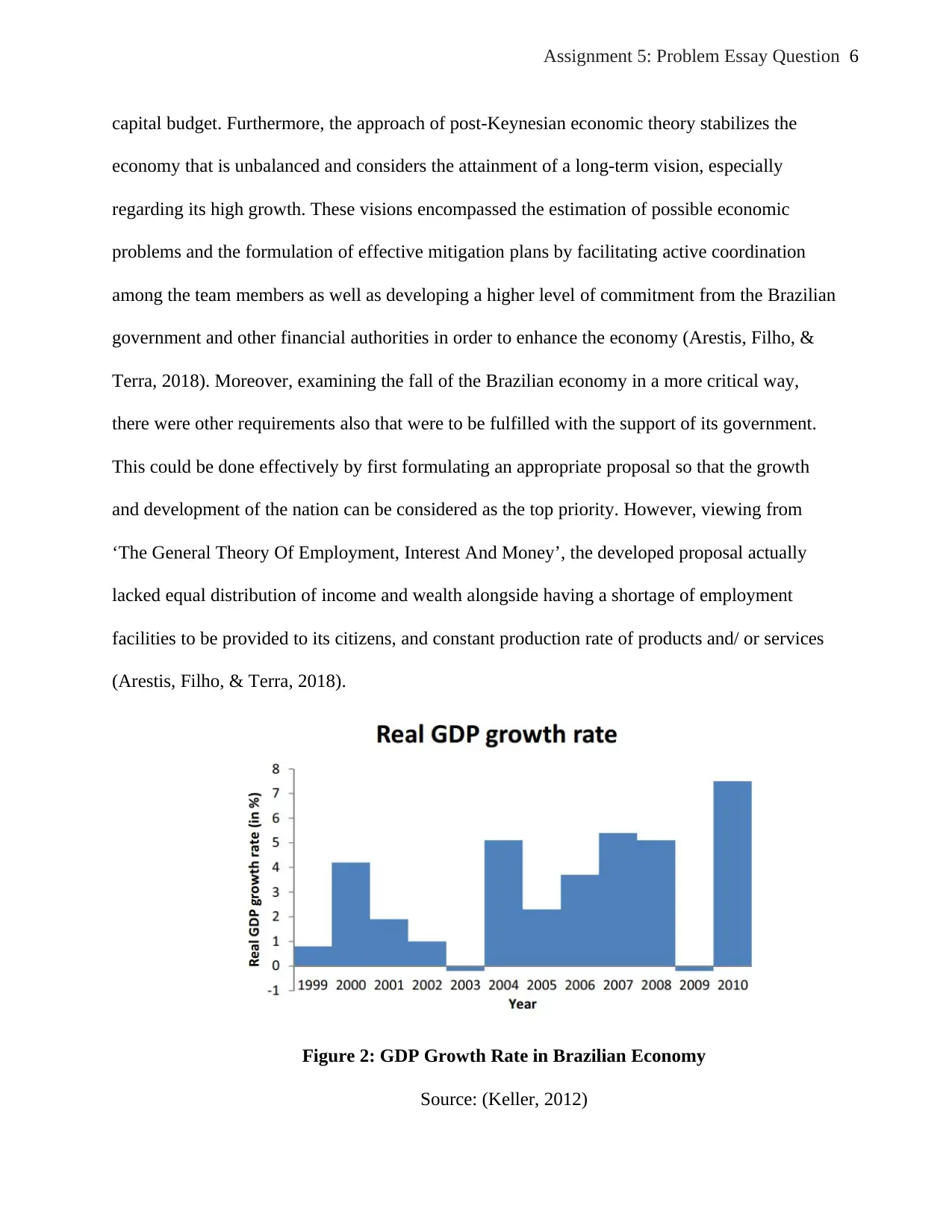
6Assignment 5: Problem Essay Question
capital budget. Furthermore, the approach of post-Keynesian economic theory stabilizes the
economy that is unbalanced and considers the attainment of a long-term vision, especially
regarding its high growth. These visions encompassed the estimation of possible economic
problems and the formulation of effective mitigation plans by facilitating active coordination
among the team members as well as developing a higher level of commitment from the Brazilian
government and other financial authorities in order to enhance the economy (Arestis, Filho, &
Terra, 2018). Moreover, examining the fall of the Brazilian economy in a more critical way,
there were other requirements also that were to be fulfilled with the support of its government.
This could be done effectively by first formulating an appropriate proposal so that the growth
and development of the nation can be considered as the top priority. However, viewing from
‘The General Theory Of Employment, Interest And Money’, the developed proposal actually
lacked equal distribution of income and wealth alongside having a shortage of employment
facilities to be provided to its citizens, and constant production rate of products and/ or services
(Arestis, Filho, & Terra, 2018).
Figure 2: GDP Growth Rate in Brazilian Economy
Source: (Keller, 2012)
capital budget. Furthermore, the approach of post-Keynesian economic theory stabilizes the
economy that is unbalanced and considers the attainment of a long-term vision, especially
regarding its high growth. These visions encompassed the estimation of possible economic
problems and the formulation of effective mitigation plans by facilitating active coordination
among the team members as well as developing a higher level of commitment from the Brazilian
government and other financial authorities in order to enhance the economy (Arestis, Filho, &
Terra, 2018). Moreover, examining the fall of the Brazilian economy in a more critical way,
there were other requirements also that were to be fulfilled with the support of its government.
This could be done effectively by first formulating an appropriate proposal so that the growth
and development of the nation can be considered as the top priority. However, viewing from
‘The General Theory Of Employment, Interest And Money’, the developed proposal actually
lacked equal distribution of income and wealth alongside having a shortage of employment
facilities to be provided to its citizens, and constant production rate of products and/ or services
(Arestis, Filho, & Terra, 2018).
Figure 2: GDP Growth Rate in Brazilian Economy
Source: (Keller, 2012)
⊘ This is a preview!⊘
Do you want full access?
Subscribe today to unlock all pages.

Trusted by 1+ million students worldwide
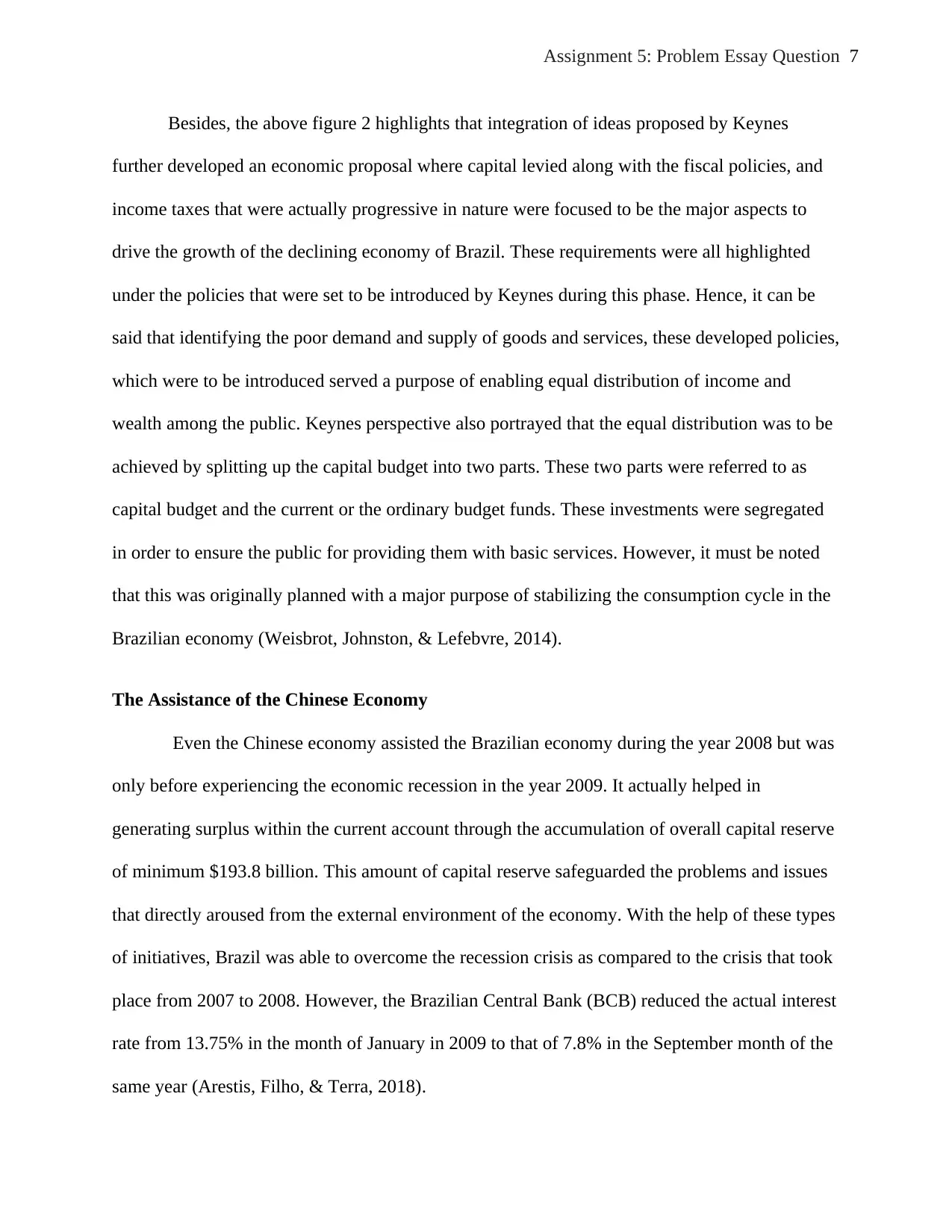
7Assignment 5: Problem Essay Question
Besides, the above figure 2 highlights that integration of ideas proposed by Keynes
further developed an economic proposal where capital levied along with the fiscal policies, and
income taxes that were actually progressive in nature were focused to be the major aspects to
drive the growth of the declining economy of Brazil. These requirements were all highlighted
under the policies that were set to be introduced by Keynes during this phase. Hence, it can be
said that identifying the poor demand and supply of goods and services, these developed policies,
which were to be introduced served a purpose of enabling equal distribution of income and
wealth among the public. Keynes perspective also portrayed that the equal distribution was to be
achieved by splitting up the capital budget into two parts. These two parts were referred to as
capital budget and the current or the ordinary budget funds. These investments were segregated
in order to ensure the public for providing them with basic services. However, it must be noted
that this was originally planned with a major purpose of stabilizing the consumption cycle in the
Brazilian economy (Weisbrot, Johnston, & Lefebvre, 2014).
The Assistance of the Chinese Economy
Even the Chinese economy assisted the Brazilian economy during the year 2008 but was
only before experiencing the economic recession in the year 2009. It actually helped in
generating surplus within the current account through the accumulation of overall capital reserve
of minimum $193.8 billion. This amount of capital reserve safeguarded the problems and issues
that directly aroused from the external environment of the economy. With the help of these types
of initiatives, Brazil was able to overcome the recession crisis as compared to the crisis that took
place from 2007 to 2008. However, the Brazilian Central Bank (BCB) reduced the actual interest
rate from 13.75% in the month of January in 2009 to that of 7.8% in the September month of the
same year (Arestis, Filho, & Terra, 2018).
Besides, the above figure 2 highlights that integration of ideas proposed by Keynes
further developed an economic proposal where capital levied along with the fiscal policies, and
income taxes that were actually progressive in nature were focused to be the major aspects to
drive the growth of the declining economy of Brazil. These requirements were all highlighted
under the policies that were set to be introduced by Keynes during this phase. Hence, it can be
said that identifying the poor demand and supply of goods and services, these developed policies,
which were to be introduced served a purpose of enabling equal distribution of income and
wealth among the public. Keynes perspective also portrayed that the equal distribution was to be
achieved by splitting up the capital budget into two parts. These two parts were referred to as
capital budget and the current or the ordinary budget funds. These investments were segregated
in order to ensure the public for providing them with basic services. However, it must be noted
that this was originally planned with a major purpose of stabilizing the consumption cycle in the
Brazilian economy (Weisbrot, Johnston, & Lefebvre, 2014).
The Assistance of the Chinese Economy
Even the Chinese economy assisted the Brazilian economy during the year 2008 but was
only before experiencing the economic recession in the year 2009. It actually helped in
generating surplus within the current account through the accumulation of overall capital reserve
of minimum $193.8 billion. This amount of capital reserve safeguarded the problems and issues
that directly aroused from the external environment of the economy. With the help of these types
of initiatives, Brazil was able to overcome the recession crisis as compared to the crisis that took
place from 2007 to 2008. However, the Brazilian Central Bank (BCB) reduced the actual interest
rate from 13.75% in the month of January in 2009 to that of 7.8% in the September month of the
same year (Arestis, Filho, & Terra, 2018).
Paraphrase This Document
Need a fresh take? Get an instant paraphrase of this document with our AI Paraphraser
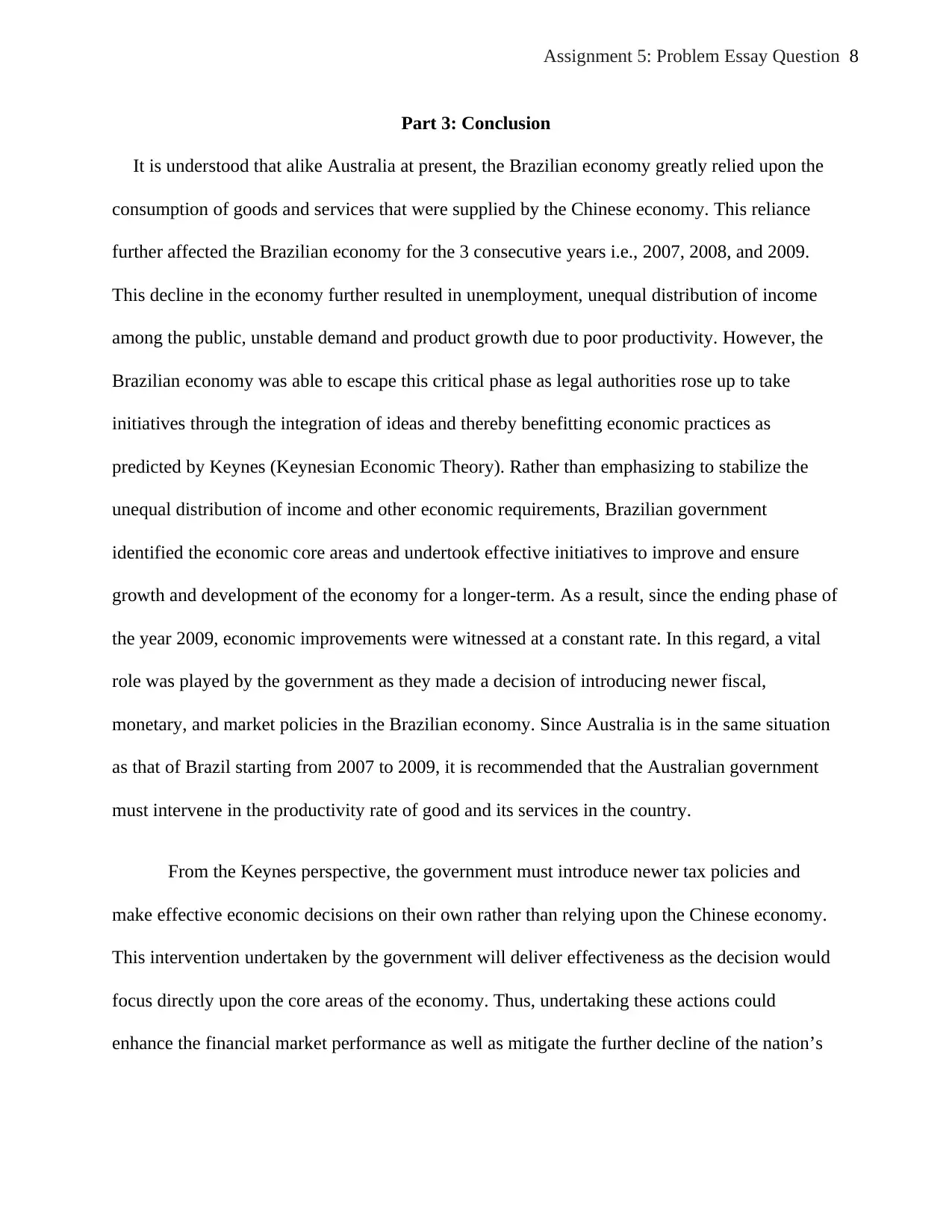
8Assignment 5: Problem Essay Question
Part 3: Conclusion
It is understood that alike Australia at present, the Brazilian economy greatly relied upon the
consumption of goods and services that were supplied by the Chinese economy. This reliance
further affected the Brazilian economy for the 3 consecutive years i.e., 2007, 2008, and 2009.
This decline in the economy further resulted in unemployment, unequal distribution of income
among the public, unstable demand and product growth due to poor productivity. However, the
Brazilian economy was able to escape this critical phase as legal authorities rose up to take
initiatives through the integration of ideas and thereby benefitting economic practices as
predicted by Keynes (Keynesian Economic Theory). Rather than emphasizing to stabilize the
unequal distribution of income and other economic requirements, Brazilian government
identified the economic core areas and undertook effective initiatives to improve and ensure
growth and development of the economy for a longer-term. As a result, since the ending phase of
the year 2009, economic improvements were witnessed at a constant rate. In this regard, a vital
role was played by the government as they made a decision of introducing newer fiscal,
monetary, and market policies in the Brazilian economy. Since Australia is in the same situation
as that of Brazil starting from 2007 to 2009, it is recommended that the Australian government
must intervene in the productivity rate of good and its services in the country.
From the Keynes perspective, the government must introduce newer tax policies and
make effective economic decisions on their own rather than relying upon the Chinese economy.
This intervention undertaken by the government will deliver effectiveness as the decision would
focus directly upon the core areas of the economy. Thus, undertaking these actions could
enhance the financial market performance as well as mitigate the further decline of the nation’s
Part 3: Conclusion
It is understood that alike Australia at present, the Brazilian economy greatly relied upon the
consumption of goods and services that were supplied by the Chinese economy. This reliance
further affected the Brazilian economy for the 3 consecutive years i.e., 2007, 2008, and 2009.
This decline in the economy further resulted in unemployment, unequal distribution of income
among the public, unstable demand and product growth due to poor productivity. However, the
Brazilian economy was able to escape this critical phase as legal authorities rose up to take
initiatives through the integration of ideas and thereby benefitting economic practices as
predicted by Keynes (Keynesian Economic Theory). Rather than emphasizing to stabilize the
unequal distribution of income and other economic requirements, Brazilian government
identified the economic core areas and undertook effective initiatives to improve and ensure
growth and development of the economy for a longer-term. As a result, since the ending phase of
the year 2009, economic improvements were witnessed at a constant rate. In this regard, a vital
role was played by the government as they made a decision of introducing newer fiscal,
monetary, and market policies in the Brazilian economy. Since Australia is in the same situation
as that of Brazil starting from 2007 to 2009, it is recommended that the Australian government
must intervene in the productivity rate of good and its services in the country.
From the Keynes perspective, the government must introduce newer tax policies and
make effective economic decisions on their own rather than relying upon the Chinese economy.
This intervention undertaken by the government will deliver effectiveness as the decision would
focus directly upon the core areas of the economy. Thus, undertaking these actions could
enhance the financial market performance as well as mitigate the further decline of the nation’s

9Assignment 5: Problem Essay Question
GDP at present. These effective interventions will also favor long-term growth and development
of the Australian economy.
GDP at present. These effective interventions will also favor long-term growth and development
of the Australian economy.
⊘ This is a preview!⊘
Do you want full access?
Subscribe today to unlock all pages.

Trusted by 1+ million students worldwide
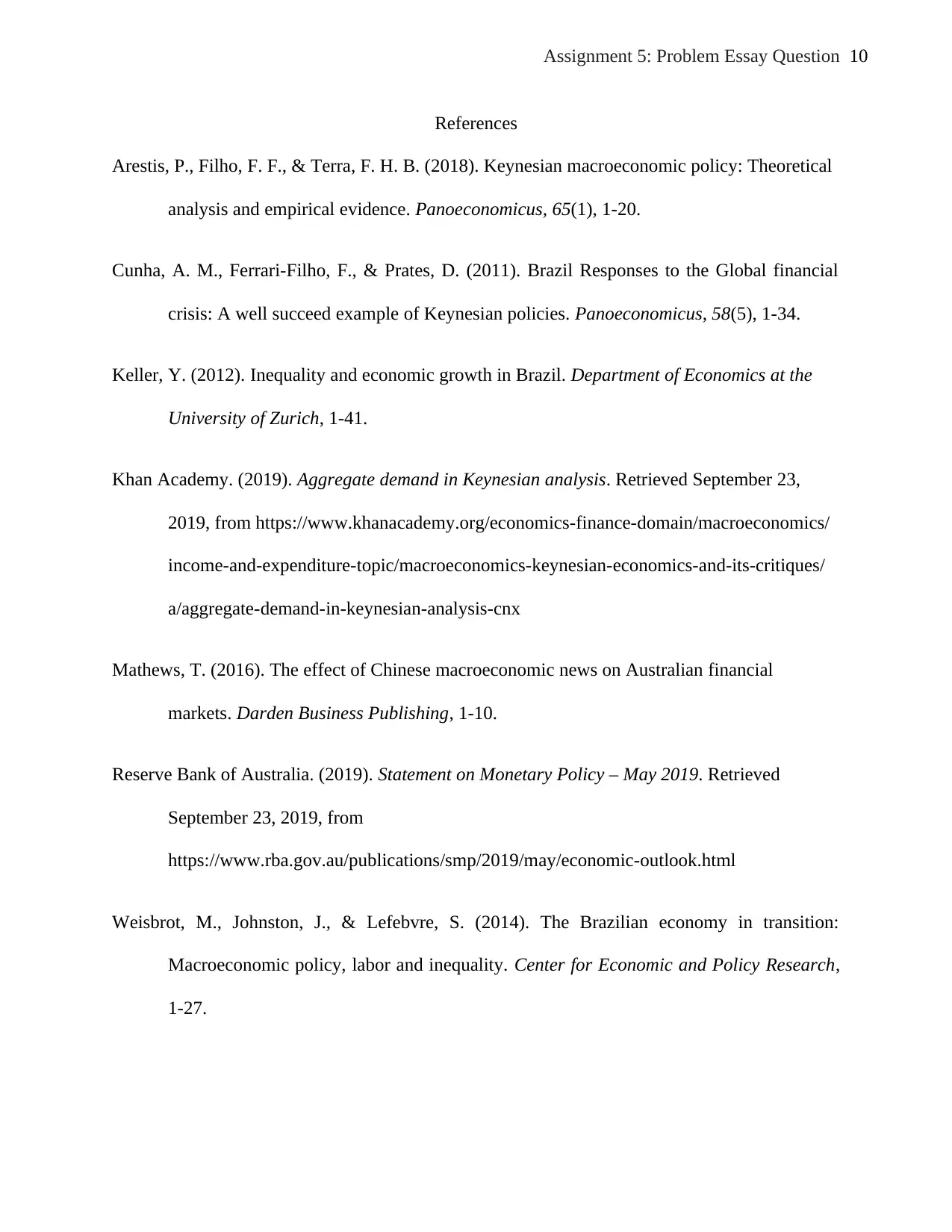
10Assignment 5: Problem Essay Question
References
Arestis, P., Filho, F. F., & Terra, F. H. B. (2018). Keynesian macroeconomic policy: Theoretical
analysis and empirical evidence. Panoeconomicus, 65(1), 1-20.
Cunha, A. M., Ferrari-Filho, F., & Prates, D. (2011). Brazil Responses to the Global financial
crisis: A well succeed example of Keynesian policies. Panoeconomicus, 58(5), 1-34.
Keller, Y. (2012). Inequality and economic growth in Brazil. Department of Economics at the
University of Zurich, 1-41.
Khan Academy. (2019). Aggregate demand in Keynesian analysis. Retrieved September 23,
2019, from https://www.khanacademy.org/economics-finance-domain/macroeconomics/
income-and-expenditure-topic/macroeconomics-keynesian-economics-and-its-critiques/
a/aggregate-demand-in-keynesian-analysis-cnx
Mathews, T. (2016). The effect of Chinese macroeconomic news on Australian financial
markets. Darden Business Publishing, 1-10.
Reserve Bank of Australia. (2019). Statement on Monetary Policy – May 2019. Retrieved
September 23, 2019, from
https://www.rba.gov.au/publications/smp/2019/may/economic-outlook.html
Weisbrot, M., Johnston, J., & Lefebvre, S. (2014). The Brazilian economy in transition:
Macroeconomic policy, labor and inequality. Center for Economic and Policy Research,
1-27.
References
Arestis, P., Filho, F. F., & Terra, F. H. B. (2018). Keynesian macroeconomic policy: Theoretical
analysis and empirical evidence. Panoeconomicus, 65(1), 1-20.
Cunha, A. M., Ferrari-Filho, F., & Prates, D. (2011). Brazil Responses to the Global financial
crisis: A well succeed example of Keynesian policies. Panoeconomicus, 58(5), 1-34.
Keller, Y. (2012). Inequality and economic growth in Brazil. Department of Economics at the
University of Zurich, 1-41.
Khan Academy. (2019). Aggregate demand in Keynesian analysis. Retrieved September 23,
2019, from https://www.khanacademy.org/economics-finance-domain/macroeconomics/
income-and-expenditure-topic/macroeconomics-keynesian-economics-and-its-critiques/
a/aggregate-demand-in-keynesian-analysis-cnx
Mathews, T. (2016). The effect of Chinese macroeconomic news on Australian financial
markets. Darden Business Publishing, 1-10.
Reserve Bank of Australia. (2019). Statement on Monetary Policy – May 2019. Retrieved
September 23, 2019, from
https://www.rba.gov.au/publications/smp/2019/may/economic-outlook.html
Weisbrot, M., Johnston, J., & Lefebvre, S. (2014). The Brazilian economy in transition:
Macroeconomic policy, labor and inequality. Center for Economic and Policy Research,
1-27.
Paraphrase This Document
Need a fresh take? Get an instant paraphrase of this document with our AI Paraphraser
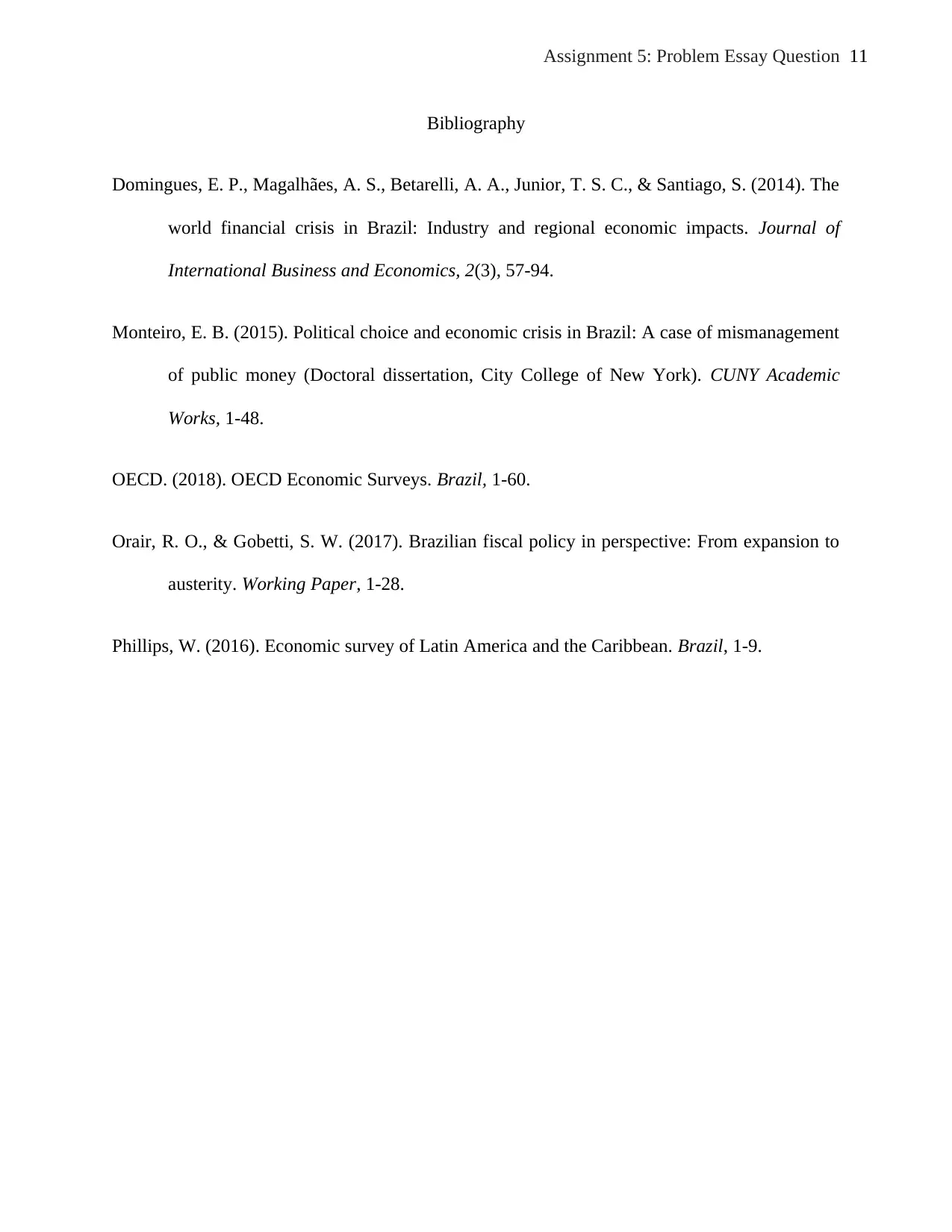
11Assignment 5: Problem Essay Question
Bibliography
Domingues, E. P., Magalhães, A. S., Betarelli, A. A., Junior, T. S. C., & Santiago, S. (2014). The
world financial crisis in Brazil: Industry and regional economic impacts. Journal of
International Business and Economics, 2(3), 57-94.
Monteiro, E. B. (2015). Political choice and economic crisis in Brazil: A case of mismanagement
of public money (Doctoral dissertation, City College of New York). CUNY Academic
Works, 1-48.
OECD. (2018). OECD Economic Surveys. Brazil, 1-60.
Orair, R. O., & Gobetti, S. W. (2017). Brazilian fiscal policy in perspective: From expansion to
austerity. Working Paper, 1-28.
Phillips, W. (2016). Economic survey of Latin America and the Caribbean. Brazil, 1-9.
Bibliography
Domingues, E. P., Magalhães, A. S., Betarelli, A. A., Junior, T. S. C., & Santiago, S. (2014). The
world financial crisis in Brazil: Industry and regional economic impacts. Journal of
International Business and Economics, 2(3), 57-94.
Monteiro, E. B. (2015). Political choice and economic crisis in Brazil: A case of mismanagement
of public money (Doctoral dissertation, City College of New York). CUNY Academic
Works, 1-48.
OECD. (2018). OECD Economic Surveys. Brazil, 1-60.
Orair, R. O., & Gobetti, S. W. (2017). Brazilian fiscal policy in perspective: From expansion to
austerity. Working Paper, 1-28.
Phillips, W. (2016). Economic survey of Latin America and the Caribbean. Brazil, 1-9.
1 out of 11
Related Documents
Your All-in-One AI-Powered Toolkit for Academic Success.
+13062052269
info@desklib.com
Available 24*7 on WhatsApp / Email
![[object Object]](/_next/static/media/star-bottom.7253800d.svg)
Unlock your academic potential
© 2024 | Zucol Services PVT LTD | All rights reserved.





